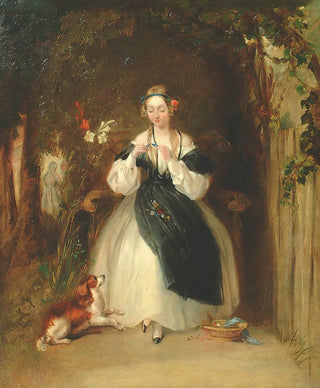Art print | A young woman plaiting her hair - William Powell Frith


View from behind

Frame (optional)
William Powell Frith's "A young woman braiding her hair" serves as a window into a bygone era, an intimate scene inviting contemplation. Created in 1852, this artwork captures a moment of everyday life of a young woman absorbed in a simple yet meaningful gesture. The delicacy of the subject, combined with meticulous detail, creates an atmosphere that is both peaceful and evocative. In this piece, Frith transcends the simple act of braiding hair to symbolize femininity and beauty, while offering a fascinating glimpse into the fashion and customs of his time. The art print of this work allows appreciation not only of the artist's technique but also of the narrative depth it conveys.
Style and uniqueness of the work
William Powell Frith's style is characterized by meticulous realism, with attention to detail that brings his characters and their environment to life. In "A young woman braiding her hair," every element is carefully crafted, from the textures of the clothing to the reflections of light on the protagonist's hair. Frith excels in capturing moments of daily life, making his works accessible and universal. The composition of this art print is also remarkable, with a harmonious arrangement of shapes and colors that guide the viewer's eye. The chosen palette, soft and nuanced, contributes to the serene atmosphere of the scene. This piece stands out not only for its technique but also for how it evokes emotions and reflections on the condition of women in the 19th century.
The artist and his influence
William Powell Frith, born in 1819, is one of the most emblematic artists of the British realist movement. His career is marked by a desire to depict the world as it is, without embellishment or idealization. Frith became known through his genre scenes, which depict moments of daily life with striking accuracy. His influence on British painting is undeniable, inspiring many artists to explore similar themes. By highlighting ordinary subjects, Frith paved the way for a new artistic approach that values

Matte finish

View from behind

Frame (optional)
William Powell Frith's "A young woman braiding her hair" serves as a window into a bygone era, an intimate scene inviting contemplation. Created in 1852, this artwork captures a moment of everyday life of a young woman absorbed in a simple yet meaningful gesture. The delicacy of the subject, combined with meticulous detail, creates an atmosphere that is both peaceful and evocative. In this piece, Frith transcends the simple act of braiding hair to symbolize femininity and beauty, while offering a fascinating glimpse into the fashion and customs of his time. The art print of this work allows appreciation not only of the artist's technique but also of the narrative depth it conveys.
Style and uniqueness of the work
William Powell Frith's style is characterized by meticulous realism, with attention to detail that brings his characters and their environment to life. In "A young woman braiding her hair," every element is carefully crafted, from the textures of the clothing to the reflections of light on the protagonist's hair. Frith excels in capturing moments of daily life, making his works accessible and universal. The composition of this art print is also remarkable, with a harmonious arrangement of shapes and colors that guide the viewer's eye. The chosen palette, soft and nuanced, contributes to the serene atmosphere of the scene. This piece stands out not only for its technique but also for how it evokes emotions and reflections on the condition of women in the 19th century.
The artist and his influence
William Powell Frith, born in 1819, is one of the most emblematic artists of the British realist movement. His career is marked by a desire to depict the world as it is, without embellishment or idealization. Frith became known through his genre scenes, which depict moments of daily life with striking accuracy. His influence on British painting is undeniable, inspiring many artists to explore similar themes. By highlighting ordinary subjects, Frith paved the way for a new artistic approach that values






